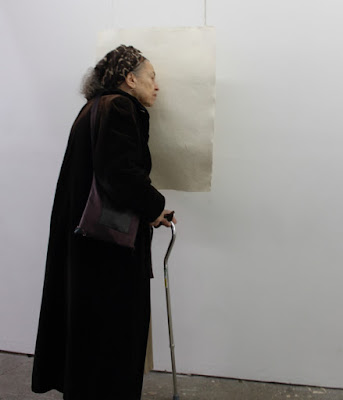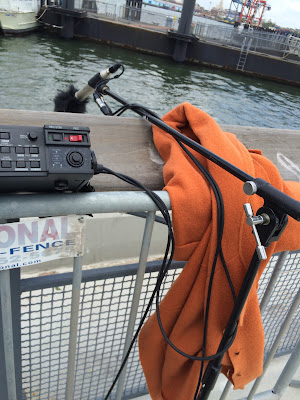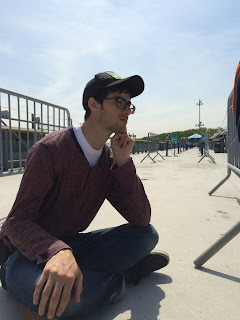"Wave Crossings” creates a wave, sound and site-specific installation. Harvestworks is sponsoring this Governors Island installation and its online presence. Liz Phillips has received a NYSCA Individual Artists commission through Harvestworks for this work.
Additional funding was received from the David Bermant Foundation through Parabola Arts Foundation
The installation will take place on Governor's Island in the Summer of 2017.
Samples
Monday, August 17, 2015
Interactive Patches
These are the patches being used in Wave Crossings. The patches were first modeled on Liz Phillips' Wavetable using analog synthesis. They were then made in Pure Data with modules taken from help files and online linked together and re-appropriated for the piece. . Liz and I have been working on the patches since early July. They process looped recordings by changing the pitch of playback and center frequency of a voltage-controlled filter based on live audio input. Another patch plays back live audio at regular pitch and transposed up. This patch also includes an inverted envelope follower that decreases the volume of playback as live audio gets louder.
-Rob Scheuering
Monday, July 27, 2015
A special guest writer on a field recording trip to Governors Island with Liz— Paula Rabinowitz (July 14,2015)
A humid early morning—Bastille Day, New York.
Liz and I cross the 59th Street Bridge along with the rush-hour traffic and head to South Ferry to board the Governor’s Island ferry. We’ve got a lunch packed, recording equipment and raingear. The ride across the East River is quick; we’re waved ashore and park near the New York Harbor School’s maritime program office to don life preservers, required while on the dock. Our mission: record low frequencies from the dock pilings. [photo 1] Liz busied herself rigging her bamboo pole and fishing rod with shells housing microphones for underwater recording [photo 2-4]; I listened to the roar of the air and water—helicopters every few minutes; a few motorboats and barges, ferries—and watched the thunderhead clouds move down the East River.
Liz put me in charge of turning on the recorder as she stood on the edge of the dock with the microphone inside the piling—a mistake, as I didn’t push the on button correctly. By this time, a group of students and their teacher had arrived to attend to the many crate of oyster shells sunk in the river’s muck, part of “the billion oyster project” overseen by the Harbor School. http://www.billionoysterproject.org/ The project aims to place one billion spat-on-shell oysters in the harbor by 2030 and the students were there to haul up the seed oysters, clean them off, check to see if the shells had spats, sort them and replace the good ones into crates. They worked diligently creating wonderful sounds as the crates crashed against the metal grates of the deck and the oysters clattered inside. [photos 5-8].
By now the rain was beginning to sprinkle and we needed to cover the equipment but were able to get some of the sounds recorded before the gray sky turned darker and even the students had gone for shelter. We hauled the microphones, recorder, headphones and gear back to the car and sat out the storm eating sandwiches.
The dock, with its ropes and cages and paddles—the detritus cluttering any dock along the coast—beckoned. [photo 9-10] The sky cleared and we set to explore Fort Jay, once an army fortification, then a coast guard station now a national park, housing a video installation. A strange beat grew louder and the rain burst in a torrent. So we waited it out under an awning, listening to the streams of water above our umbrellas. It was time to leave.
paula rabinowitz
Pilings
Liz at Work
Ropes
Shell Microphone
Spat on Oyster
Kids hauling
Sludge Oysters
Clean Oysters
Paddle
Cages
Tuesday, June 30, 2015
Sunday, June 14, 2015
The Original Proposal
Liz Phillips: Wave Crossings create Chladni Figures in this wave, sound and site-specific installation.The audience/participants explore, creating patterns that amplify and reinforce the sonic architecture of the chapel.
Multi-channel simultaneous recordings from the waters around the Island create the sound and signal material for the installation.
Movement is sensed using ultrasonics and telemetry systems to create an ever-changing dynamic water and soundscape.
THE STAINED
GLASS / WAVE TABLES- The changing light from the three sides of stain
glass windows and the waves in the table. They mix as projected and
reflected light and changes in the sound in the church through
processing.
Chladni figures
appear like live script being written in illuminations on the
Wavetable, a surface of water modulated with sub audio and audio..
THE MIX—LISTENING – Light shifts as well as movement within and is harnessed to change the sound.
Listening,
like in a rowboat, we are immersed in deep sonic patterns.Many sounds
begin and end like waves rolling in with great force and shape.
The
sound palette (with filters, transposition, synthesis and live
processing) will vary, with deeply resonant voices, configuring and
reconfiguring.
Wave Tables and Object Loudspeakers
From Annea Lockwood — observations from our day of recording on the Harbor School dock…
"The bamboo tube hydrophone, four hydrophones really, was a lovely surprise to me, largely because I hadn't realized that the tube's resonance would add so much to the intermittent sounds we were finding, and so beautifully - what ingenuity!
So it was most interesting to go back and forth listening to two different hydrophone set-ups of the same site and, as I always find with field recording, a serene experience with that twist of never being able to anticipate what sounds may pop up next.
There was also a fair amount of shipping moving through Buttermilk Channel, which always makes me happy to see and hear. Vania Hinkova, a Serbian poet I met once on the Danube said that when that river was blocked to shipping, (after NATO bombed the three bridges at Novi Sad)
it was as if the river had died, so deeply linked, at least to us humans, are the people and the river. "
Saturday, June 13, 2015
Thank you
the David Bermant Foundation and Parabola Arts Foundation, Inc. for their support!
Harvestworks, Ohm Acoustics, New York State Council of the Arts, Trinity Church, The Governor's Island Trust, the New York Harbor School, and The Billion Oyster Project
Harvestworks, Ohm Acoustics, New York State Council of the Arts, Trinity Church, The Governor's Island Trust, the New York Harbor School, and The Billion Oyster Project
Wednesday, June 10, 2015
Inspirations for Wave Crossings

A chart of Chladni Patterns discovered by Ernst Chladni and first published in 1787.
Ernst Chladni
Polynesian Stick Chart
navigation training device. Also known as a mattang. From the Marshall
Islands, Micronesia. Probably 19th or early 20th century. Charts
were used to demonstrate and map the relationship
between Pacific islands and ocean swells. System of mapping ocean
swells had not been accomplished before. Made from bamboo.
Tuesday, June 9, 2015
WAVE CROSSINGS 2015 by Liz Phillips
"Wave Crossings”
creates Chladni Figures in this wave, sound
and site-specific installation. Harvestworks is sponsoring this
Governors Island installation and its online presence. Liz Phillips has
received a NYSCA Individual Artists commission through Harvestworks for
this work for 2015. "Wave Crossings" uses our full senses and
telemetry systems (of sensors) to explore, amplify and reinforce the
sonic architecture of a chapel (Cornelius) with the waterscape of the
Island.
This
is one of two Wavetables. The surface vibrates into Chladni patterns.
We are recording the harbor sound and tides from three
places on the island to playback through Ohm Acoustics omnidirectional
speakers and homemade speaker objects (shells and bamboo and paper) located within the church. Monday, June 8, 2015
Subscribe to:
Posts (Atom)












































